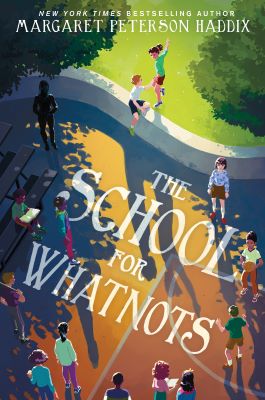The School for Whatnots: Frequently Asked Questions
Note: My answers may contain some spoilers for the book—please don’t read this if you haven’t finished the book!
Where did you get the idea for The School for Whatnots?
The inspiration for this book was a little bizarre... I got the idea from just reading the title of another author's book! I was reading reviews of upcoming books on the Publishers Weekly website, and I saw that an author named M.M. Vaughan had a book coming out called "Friendroid." As soon as I saw that title, I thought, "Oh, I know what that book must be about! Parents are so worried about their kids having friendship issues that they only let them be friends with androids specifically designed to be their friends. So the real kids will never have to worry about being bullied, or having friends outgrow them, or having their friends just decide they like a different friend more... kids in that book will have it so easy! (Until something goes wrong...) What a great idea for a book! I am so jealous that another author thought of it first and got to have the fun of writing that book!" And then I read the actual description of the other author's book, and... that wasn't the plot at all. (It still sounded like a great book; it was just totally different than I expected.) At that point, I thought, "Wait, if that's not the plot of that book, that means I don't have to be jealous of that other author! Nobody's written a book with that plot yet! So I can write it!" From there, I refined my original idea quite a bit, and shifted the focus from what parents wanted to how kids would deal with the lives their parents arranged for them. But I definitely need to give M.M. Vaughan credit for inspiring me with her creative title.
Why did you decide to have a narrator tell the story? And why did you include the narrator's "asides"? And did you know from the beginning that the narrator would also be a character in the story?
At the beginning of the book, neither Max nor Josie nor any of the other kids (or parents!) know the whole story of what's really going on at their school. So I knew it would be hard, if not impossible, to tell the story just from Max or Josie's perspective. I wrote the first chapter of the book almost as an experiment, and then immediately I could hear the narrator's voice in my head wanting to explain everything but also wanting to be snarky about what she knew but others didn't. I had so much fun with that voice. And then as the book went along, it was a surprise for me, too, to find out that the narrator didn't exactly know as much as she thought. The day I figured out who the narrator was--that she wasn't just a disembodied voice--I was so happy with the twist. It was like doing a jigsaw puzzle, and realizing that I'd been holding the missing piece in my hand all along.
Is there going to be a sequel to The School for Whatnots?
I don't have any plans to write one. I feel that the story wrapped up enough by the end of the book for me to feel confident that Josie, Max, Ivy, and all their families and friends are going to be okay. I'm happy to let readers use their imagination to figure out what happens next.
But I have to admit that I have felt that way about other books I thought were going to stay forever as standalones, and then I did ultimately end up writing a sequel, sometimes many years later. So I have learned to never say never!



Connect with Margaret: